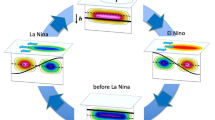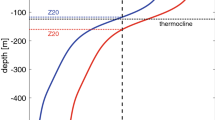Abstract
El Niño/Southern Oscillation (ENSO) phenomenon lately appears to have a much fast pace with four warming events in the past decade (2002–2012). Three out of four events have their warming centers confined in the equatorial central Pacific. It is argued that the anomalous zonal sea currents are responsible for the fast transition of the central Pacific warming. Furthermore, based on the heat budget analysis, it is found that zonal advective feedback appears to play an important role in the phase transition of central Pacific ENSO, although the thermocline feedback process that is essential for ENSO, as delineated by the recharge/discharge oscillator theory, also contributes but mainly in the eastern Pacific. A stability analysis is performed using a simple stripped-down coupled model with two different basic state settings derived from the periods over 1982–2001 and 2002–2012, respectively. In the two periods, the basic states show different distribution along the equator and the leading ENSO-like eigen-modes have very different periods and patterns. The mode under the basic state in the earlier period resembles the eastern Pacific ENSO with a period about 5 years, whereas under the basic state in the recent decade, the ENSO mode becomes more like the observed central Pacific ENSO with a period about 2 years. The slow eastern Pacific ENSO mode is dominated by the thermocline feedback and behaves more like the recharge oscillator, whereas the zonal advective feedback plays a significant role in the fast-paced central Pacific ENSO mode. These results are roughly consistent with the broad features of two types of ENSO. In addition, the zonal advective feedback contributes to the phase transitions of both types of ENSO-like modes. In a word, the recent fast-paced ENSO activities in the central Pacific is suggested due to the dominance of zonal advective feedback favored by the tropical Pacific basic state conditions in the past decade.








We’re sorry, something doesn't seem to be working properly.
Please try refreshing the page. If that doesn't work, please contact support so we can address the problem.
Similar content being viewed by others
Notes
The altimeter products were produced by the CLS Space Oceanography Division as part of the Environment and Climate EU ENACT project (EVK2-CT2001-00117) and with support from CNES.
References
An S-I, Jin F-F (2001) Collective role of zonal advective and thermocline feedbacks in ENSO mode. J Clim 14:3421–3432
An S-I, Wang B (2000) Interdecadal change of the structure of the ENSO mode and its impact on the ENSO frequency. J Clim 13:2044–2055
An S-I, Jin F-F, Kang I-K (1999) The role of zonal advection feedback in phase transition and growth of ENSO on the Cane-Zebiak Model. J Meteorol Soc Jpn 77:1151–1160
Ashok K, Behera SK, Rao SA, Weng H, Yamagata T (2007) El Niño Modoki and its possible teleconnection. J Geophys Res 112, C11007
Barnett TP (1991) The interaction of multiple time scales in the tropical climate system. J Clim 4:269–285
Battisti DS, Hirst AC (1989) Interannual variability in a tropical atmosphere–ocean model: influence of the basic state, ocean geometry, and nonlinearity. J Atmos Sci 46:1687–1712
Behringer DW, Ji M, Leetmaa A (1998) An improved coupled model for ENSO prediction and implication for ocean initialization. Part I: the ocean data assimilation system. Mon Weather Rev 126:1013–1021
Bejarano L, Jin F-F (2008) Coexistence of equatorial coupled modes of ENSO. J Clim 21:3051–3067
Bonjean F, Lagerloef GSE (2002) Diagnostic model and analysis of the surface currents in the tropical Pacific Ocean. J Phys Oceanogr 32(10):2938–2954
Burgers G, Jin F-F, Oldenborgh GJ (2005) The simplest ENSO recharge oscillator. Geophys Res Lett 32, L13706
Cane MA, Sarachik ES (1981) The periodic response of a linear baroclinic equatorial ocean. J Mar Res 39:651–693
Cane MA, Munnich M, Zebiak SE (1990) A study of self-excited oscillations of the tropical ocean–atmosphere system. Part I: linear analysis. J Atmos Sci 47:1562–1577
Fedorov AV, Philander SG (2000) Is El Niño changing? Science 288:1997–2002
Fedorov AV, Philander SG (2001) A stability analysis of tropical ocean–atmosphere interactions: bridging measurements and theory for El Niño. J Clim 14:3086–3101
Hu Z-Z, Kumar A, Jha B, Wang W, Huang B, Huang B (2012) An analysis of warm pool and cold tongue El Niños: air-sea coupling processes, global influences, and recent trends. Clim Dyn 38:2017–2035
Hu Z-Z, Kumar A, Ren H-L, Wang H, L’Heureux M, Jin F-F (2013) Weakened interannual variability in the tropical Pacific ocean since 2000. J Clim 26:2601–2613
Ji M, Leetmaa A, Derber J (1995) An ocean analysis system for seasonal to interannual climate studies. Mon Weather Rev 123:460–481
Jin F-F (1996) Tropical ocean–atmosphere interaction, the Pacific cold tongue, and the El Niño-Southern Oscillation. Science 274:76–78
Jin F-F (1997a) An equatorial ocean recharge paradigm for ENSO. Part I: conceptual model. J Atmos Sci 54:811–829
Jin F-F (1997b) An equatorial ocean recharge paradigm for ENSO. Part II: a stripped-down coupled model. J Atmos Sci 54:830–847
Jin F-F (2001) Low-frequency modes of the tropical ocean dynamics. J Clim 14:3874–3881
Jin F-F, An S-I (1999) Thermocline and zonal advective feedbacks within the equatorial ocean recharge oscillator model for ENSO. Geophys Res Lett 26:2989–2992
Jin F-F, Neelin JD (1993) Modes of interannual tropical ocean–atmosphere interaction—a unified view. Part I: numerical results. J Atmos Sci 50:3477–3503
Jin F-F, Kug J, An S-I (2003) A near-annual coupled mode in the equatorial Pacific Ocean. Geophys Res Lett 30:1080
Jin F-F, Kim S-T, Bejarano L (2006) A coupled-stability index for ENSO. Geophys Res Lett 33, L23708
Kang I-S, An S-I, Jin F-F (2001) A systematic approximation of the SST anomaly equation for ENSO. J Meteorol Soc Jpn 79:1–10
Kang I-S, Kug J-S, An S-I, Jin F-F (2004) A near annual Pacific Basin mode. J Clim 17(12):2478–2488
Kao H-Y, Yu J-Y (2009) Contrasting eastern-Pacific and central-Pacific types of ENSO. J Clim 22:615–632
Kirtman BP (1997) Oceanic Rossby wave dynamics and the ENSO period in a coupled model. J Clim 10:1690–1704
Kug J-S, Jin F-F, An S-I (2009) Two-types of El Niño events: cold tongue El Nino and warm pool El Nino. J Clim 22:1499–1515
Kumar A, Hu Z-Z (2013) Interannual and interdecadal variability of ocean temperature along the equatorial Pacific in conjunction with ENSO. Clim Dyn. doi:10.1007/s00382-013-1721-0
Larkin NK, Harrison DE (2005) On the definition of El Niño and associated seasonal average U.S. weather anomalies. Geophys Res Lett 32:L13705
Lee T, McPhaden MJ (2010) Increasing intensity of El Niño in the central equatorial Pacific. Geophys Res Lett 37, L14603
McPhaden MJ (2012) A 21st century shift in the relationship between ENSO SST and warm water volume anomalies. Geophys Res Lett 39, L09706
McPhaden MJ, Lee T, McClurg D (2011) El Niño and its relationship to changing background conditions in the tropical Pacific Ocean. Geophys Res Lett 38, L15709
Meinen CS, McPhaden MJ (2000) Observations of warm water volume changes in the equatorial Pacific and their relationship to El Niño and La Niña. J Clim 13:3551–3559
Neelin JD, Jin F-F (1993) Modes of interannual tropical ocean–atmosphere inter-action—a unified view Part II: analytical results in weakly-coupled cases. J Atmos Sci 50:3504–3522
Picaut J, Masia F, du Penhoat Y (1997) An advective–reflective conceptual model for the oscillatory mature of the ENSO. Science 277:663–666
Rasmusson EM, Carpenter TH (1982) Variations in tropical sea surface temperature and surface wind field associated with the Southern Oscillation/El Niño. Mon Weather Rev 110:354–384
Rayner NA, Parker DE, Horton EB, Folland CK, Alexander LV, Rowell DP, Kent EC, Kaplan A (2003) Global analyses of sea surface temperature, sea ice, and night marine air temperature since the late nineteenth century. J Geophys Res 108(D14):4407
Ren H-L, Jin F-F (2011) Niño indices for two types of ENSO. Geophys Res Lett 38, L04704
Ren H-L, Jin F-F (2013) Recharge oscillator mechanisms in two types of ENSO. J Clim 26(17):6506–6523
Ren H-L, Jin F-F, Stuecker MF, Xie R-H (2013) ENSO regime change since the late 1970s as manifested by two types of ENSO. J Meteorol Soc Jpn 91(6):835–842
Santoso A, McGregor S, Jin F-F, Cai W, England MH, An S-I, McPhaden MJ, Guilyardi E (2013) Late-twentieth-century emergence of the El Nino propagation asymmetry and future projections. Nature 504:126–130
Schopf PS, Suarez MJ (1988) Vacillations in a coupled ocean–atmosphere model. J Atmos Sci 45:549–566
Thual S, Dewitte B, An S-I, Ayoub N (2011) Sensitivity of ENSO to stratification in the recharge–discharge conceptual model. J Clim 2011(24):4332–4349
Trenberth KE (1976) Spatial and temporal variations of the Southern Oscillation. Q J R Meteorol Soc 102:639–654
Trenberth KE (1984) Signal versus noise in the Southern Oscillation. Mon Weather Rev 112:326–332
Vimont DJ, Battisti DS, Hirst AC (2001) Footprinting: a seasonal connection between the tropics and mid-latitudes. Geophys Res Lett 28(20):3923–3926
Vimont DJ, Wallace JM, Battisti DS (2003) The seasonal footprinting mechanism in the Pacific: implications for ENSO. J Clim 16:2668–2675
Vimont DJ, Alexander M, Fontaine A (2009) Midlatitude excitation of tropical variability in the Pacific: the role of thermodynamic coupling and seasonality. J Clim 22(3):518–534
Wang B, An S-I (2005) A method for detecting season-dependent modes of climate variability: S-EOF analysis. Geophys Res Lett 32, L15710
Weng H, Ashok K, Behera SK, Rao SA, Yamagata T (2007) Impacts of recent El Niño Modoki on dry/wet conditions in the Pacific rim during boreal summer. Clim Dyn 29:113–129
Xiang B-Q, Wang B, Li T (2013) A new paradigm for the predominance of standing Central Pacific Warming after the late 1990s. Clim Dyn 41(2):327–340
Xie R-H, Huang F, Ren H-L (2013) Subtropical air–sea interaction and the development of the Central Pacific El Niño. J Ocean Univ China 12(2):260–271
Yeh S-W, Kug J-S, Dewitte B, Kwon MH, Kirtman BP, Jin F-F (2009) El Niño in a changing climate. Nature 461:511–515
Yu J-Y, Kim S-T (2011) Relationships between extratropical sea level pressure variations and the Central Pacific and Eastern Pacific types of ENSO. J Clim 24:708–720
Zebiak SE (1986) Atmospheric convergence feedback in a simple model for El Niño. Mon Weather Rev 114:1263–1271
Zebiak SE, Cane MA (1987) A model El Niño and Southern Oscillation. Mon Weather Rev 115:2262–2278
Zhang Q, Kumar A, Xue Y, Wang W, Jin F-F (2007) Analysis of the ENSO cycle in the NCEP coupled forecast model. J Clim 20:1265–1284
Zhang W-J, Li J-P, Jin F-F (2009) Spatial and temporal features of ENSO meridional scales. Geophys Res Lett 36, L15605
Zhang W, Jin F-F, Li J-P, Ren H-L (2011) Contrasting impacts of two-type El Niño over the western north Pacific during boreal autumn. J Meteorol Soc Jpn 89:563–569
Zhang W, Jin F-F, Zhao J-X, Li J-P (2013) On the bias in simulated ENSO SSTA meridional widths of CMIP3 models. J Clim 26:3173–3186
Acknowledgments
Dr. Ruihuang Xie and Prof. Fei Huang are jointly sponsored by the National Basic Research Program of China (973 Program: 2010CB951403 and 2012CB955604) and National Natural Science Foundation of China (No. 40975038, 40830106, 41230420). Prof. F.-F. Jin is jointly supported by National Science Foundation (NSF) Grants ATM1034798 and DOE Grant DE-SC0005110. Dr. Jian Huang is supported by National Public Benefit Research Foundation (Meteorology) (GYHY200906008). Dr. Xie thanks the Chinese Scholarship Council for providing financial support during visiting Prof. F.-F. Jin. The authors thank two anonymous reviewers for their assistance in evaluating this paper.
Author information
Authors and Affiliations
Corresponding author
Rights and permissions
About this article
Cite this article
Xie, R., Huang, F., Jin, FF. et al. The impact of basic state on quasi-biennial periodicity of central Pacific ENSO over the past decade. Theor Appl Climatol 120, 55–67 (2015). https://doi.org/10.1007/s00704-014-1150-y
Received:
Accepted:
Published:
Issue Date:
DOI: https://doi.org/10.1007/s00704-014-1150-y




